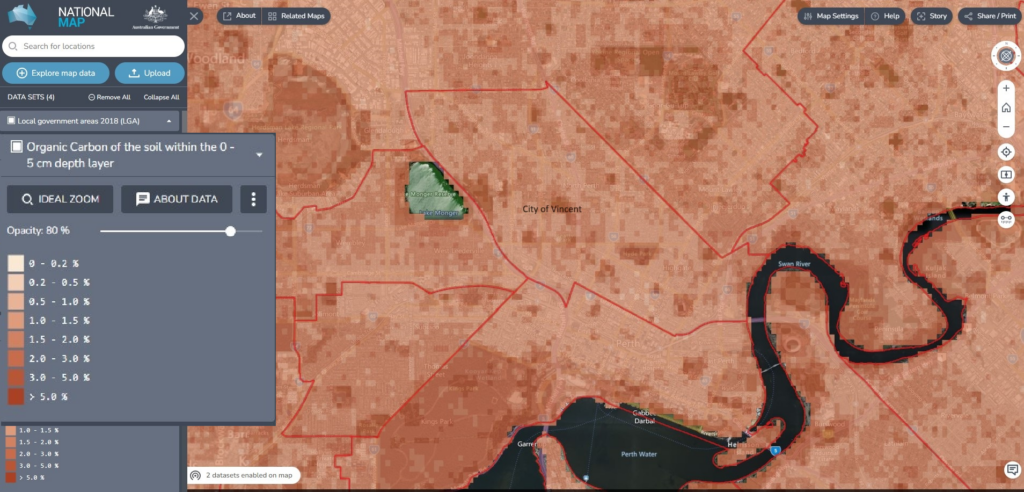Soil Organic Carbon and Urban Soil

Soil organic carbon in the top 0-5cm in the City of Vincent and surrounds (Click to go to original map)
Introduction
Soil and terrestrial vegetation are carbon sinks with around two thirds of the terrestrial carbon pool sequestered in soil (ASOE,2021). Clearing, development and management of land for intensive landuses such as agriculture and urban have resulted in the loss of significant amounts of terrestrial carbon and organic matter with Australia listed as number 3 (behind China and the United States) among countries with the highest loss of soil organic carbon (SOC) (ASOE, 2021). At the same time the natural processes that replenish soil organic carbon have been lost.
Significant efforts are being made particularly in the agricultural sector to restore terrestrial carbon, however, in the urban environment this is largely ignored. This is despite the significant benefits such as improving soil water holding capacity and fertility and associated plant health. These in turn can address major issues affecting urban areas including increased water demand and reduced water availability, the urban heat island effect, increased stormwater runoff and flooding, reduced water quality and management of organic waste streams.
The potential to transform urban areas from carbon sources to carbon sinks has been demonstrated by the Stockholm Biochar Project which aimed to make Stockholm the world’s first urban carbon sink and to have 100,000 residents using biochar by 2020. Many other cities and towns are now following Stockholm’s lead. Biochar, a form of charcoal (a resistant form of carbon), has been used extensively by the City of Stockholm and its residents in conjunction with compost to improve soil fertility and water holding capacity resulting in significant improvements to tree health and canopy cover and water management. Following Stockholm’s lead and with the support of the City of Vincent, Transition Town Vincent (TTV) used both FOGO compost and biochar and microbes in their community food forest planting with impressive results. The benefits of using organics in community gardens has also been supported by another local study: Soil health and carbon storage in community gardens in the Perth metropolitan area, Australia by Zhao et al. (2024) which identified significant improvements in total carbon and associated soil health parameters (e.g. soil water holding capacity, microbial activity, water repellence) because of the use of compost in the sandy soils of these gardens. Inspired by these projects the TTV has now established the My Healthy Soils Project to empower local residents and others to increase soil organic carbon and health while providing other benefits including recovering resources from organic waste, reducing water use and improving plant health and associated vegetation and canopy cover.
Problem and opportunity assessment
Western Australia’s population is forecast to grow from about 2.7 million to up to 5.6 million by 2056 (State Planning Strategy, 2014). The majority of these people will be housed in urban areas with significant investment being made to transform both infill and greenfield areas to house this population on land devoid of carbon and nutrients but requiring healthy soils and vegetation to mitigate urban heat island effects and a warming, drying climate.
Low levels of soil organic carbon (SOC) and organic matter (SOM) in urban soils and gardens are contributing to high levels of water use, poor plant health and sub-optimal tree canopy cover. With a regenerative and circular approach to the management of organic resources, urban gardens can be transformed from a carbon source to a carbon sink, resulting in healthier soils providing a range of benefits including better water management and healthier plants and canopy cover. Achievement of this outcome will require those all those responsible for management of urban soils to be provided with the required resources, knowledge, skills and support.
Modelling of soil organic carbon has been undertaken Nationally with the modelling represented in mapping. You can view the mapping here and enquire to find out how much carbon there is in the top 30cm of your soil. The modelling indicates generally, that in residential and commercial areas the amount of SOC is in the order of about 1-1.5%, playing fields and parklands are around 2-2.5%. There are some areas in the Perth region which have around 4-5% SOC in the top 30cm. These tend to be protected areas in the Perth hills water catchment.
| Location | SOC % (0-30cm) |
| Food forest | 1.2 |
| Floreat Athena playing fields | 1.9 |
| Tool library | 1.2 |
| Hyde Park | 2.5 |
| Leederville | 1.0 |
| Smiths Lake | 1.9 |
| Banks Reserve | 2.0 |
| Kings Park | 2.4 |
| Pickle District | 1.0 |
| City of Vincent offices | 1.3 |
Transition Town Vincent (TTV) is a community based organisation which has been established in the City of Vincent for 10 years where it has been at the forefront of civic leadership and empowerment related to sustainability. Recent projects have included the community composting station (replaced by FOGO), the tools n things library, movie nights and the food forest. In addition to providing a cluster of community leadership and extensive networks, the TTV is located in an area which provides a local resource hub /circularity precinct for servicing the project. Similarly, it has an extensive network across the Perth region and WA regional communities.
The project initially aims to engage with residents in the vicinity of the existing circularity hub / precinct to implement best practice soil health enhancement practices using organics including compost, biochar, mulch and liquid biofertiliser e.g. worm juice. In addition to increasing soil carbon, other outcomes expected include healthy carbon sequestering gardens with healthy green / canopy cover and reduced irrigation requirements. The project will support these residents in improving the carbon content and health of their soils and gardens and will develop a scalable model for empowering residents to incorporate organics into their gardens / verges.
Resources
See My Healthy Soils project page and the project resources page for links to information and resources including videos about urban areas as carbon sinks and the use of biochar in particular.
Contact
Email: ian.kininmonth@ttv.org.au
Notes:
Charcoal a.k.a. biochar is a form of resistant carbon which naturally makes up around 10% of soil organic matter with humus e.g. compost/mulch making up 50% and particulate making up about 2-25% (DPIRD, 2022).
